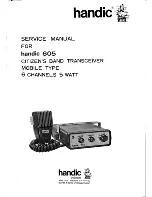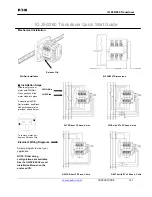
49
Maintenance / Reference
7URXEOHVKRRWLQJ
Please check the list below before concluding that the transceiver is faulty.
If a problem persists, reset the transceiver. This can sometimes correct erroneous operation.
Problem
Possible Causes
Potential Solutions
Power is on, nothing
appears on the
display
a. + and – polarities of power
connection are reversed.
a. Correctly connect the red lead and the
black lead of the DC power cable
provided respectively to the plus and
minus terminals.
b. Fuse is blown.
b. Check and solve the problem resulting
in blown fuse and replace it with a new
one with the same rated capacity.
c. Power supply or DC/DC convertor
is not turned on.
c. Turn on the power supply or DC/DC
convertor.
Display is too dim.
Dimmer setting level is low.
Make the dimmer level setting higher.
No sound comes
from the speaker.
The unit does not
receive.
a. The volume knob is rotated too
much counter-clockwise.
a. Set the volume knob properly.
b. Squelch is muted.
b. Decreases squelch level.
c. Tone or DCS squelch is active
c. Turn tone or DCS squelch off.
d. PTT key of the microphone is
pressed for transmission.
d. Immediately release PTT switch.
e. External speaker is defected.
e. Remove the jack from the external
speaker terminal and check external
speaker.
Keys and the dial do
not function.
Key-lock function is activated ([
] is
on).
Cancel key-lock function.
Rotating the dial will
not change memory
channel.
a. No memory is programmed.
b. The unit is in CALL mode.
a. A. Program memory
b. Press V/M key to cancel CALL mode.
Pressing the UP/
DOWN key will not
change frequencies
or memory channels.
a. The unit is in CALL mode.
b. Lock switch on the microphone is
ON.
a. Press V/M key to cancel CALL mode.
b. Turn off the lock switch on the
microphone.
PTT key is pressed
but transmission does
not occur.
a. Microphone terminal is not properly
inserted.
b. Antenna is not connected.
c. [OFF] appears on the display.
a. Properly insert the microphone
connection.
b. Properly connect the antenna.
c. Cancel SHIFT or set within the band.
d. Transmit inside transmission range.
Noise
• When reception frequencies fall in any one of the formula below, the unit may receive a
non-modulated signal.
This is due to the structure of frequencies of this unit and not a malfunction of the unit.
(Reception frequency on the left side VHF band – 21.7MHz) X 3 = UHF reception frequency
on the right side)
(Reception frequency on the left side UHF band – 21.7MHz) X 3 – (VHF reception frequency
on the right side + 30.85MHz) X 7 = 30.85 MHz
• When reception frequency is 3 times bigger than transmission frequency, transmitted voice
will be heard and [FREQ X3] appears on the display.
Demonstration mode
This is to set unit for exhibition purpose. Display changes automatically. Demonstration mode
can stop temporary for 10 minutes if by rotating dial. To enter activate Key-Lock function then
turn off the radio. Turn on radio while pressing MW and H/L key together. Repeat to
deactivate the mode.
NOTE
The transceiver automatically returns to demonstration mode after 10 min. in
which no operations are performed.


































